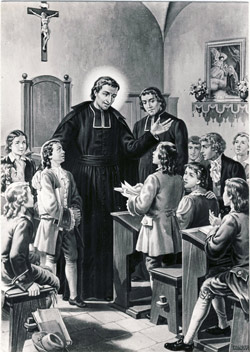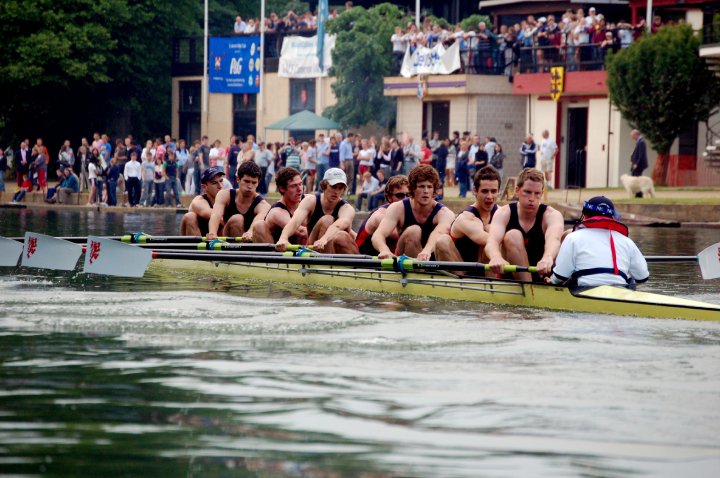|
George Swinnock
George Swinnock (1627–1673) was an English nonconformist clergyman and writer. Early life Swinnock was born at Maidstone in Kent in 1627, the son of George Swinnock of Maidstone, whose father was mayor of the borough. Owing to the death of his father, George Swinnock, jun., was brought up in the house of his uncle Robert, a zealous puritan. He was educated at Emmanuel College, Cambridge, whence he removed on 7 October 1645 to Jesus College (Addit. MS. 5820, f. 162); he graduated B.A. in 1647–8, and then proceeded to Oxford to obtain preferment, entering as a commoner at Magdalen Hall. Church career On 19 January 1648–9 Swinnock became chaplain at New College, and on 6 October following he was made a fellow of Balliol College by the parliamentary visitors. He was incorporated B.A. on 29 November 1650, and graduated M.A. on the next day. In the same year he resigned his fellowship, and was appointed vicar of Rickmansworth in Hertfordshire. In 1655 he was appointed to St. L ... [...More Info...] [...Related Items...] OR: [Wikipedia] [Google] [Baidu] |
Nonconformist (Protestantism)
Nonconformists are Protestant Christians who do not "conform" to the governance and usages of the established church in England, and in Wales until 1914, the Church of England. Use of the term ''Nonconformist'' in England and Wales was precipitated by the Restoration of the Stuart monarchy in 1660, when the Act of Uniformity 1662 renewed opposition to reforms within the established church. By the late 19th century the term specifically included other Reformed Christians ( English Presbyterians and Congregationalists), plus the Baptists, Brethren, Methodists, and Quakers. English Dissenters, such as the Puritans, who violated the Act of Uniformity 1558 – typically by practising radical, sometimes separatist, dissent – were retrospectively labelled as Nonconformists. In Ireland, the comparable term until the Church of Ireland's disestablishment in 1869 was Dissenter (the term earlier used in England), commonly referring to Irish Presbyterians who dissented from th ... [...More Info...] [...Related Items...] OR: [Wikipedia] [Google] [Baidu] |
Aston Clinton
Aston Clinton is a historic village and civil parish in the Vale of Aylesbury in Buckinghamshire, England. The village lies at the foot of the Chiltern Hills, between the Wendover and Aylesbury arms of the Grand Union Canal. Surrounding towns include Wendover to the south, Aylesbury to the west, and Tring to the east - across the nearby county border with Hertfordshire. History It is believed that the village started at the crossing of two Roman roads, Akeman Street and Icknield Way, both of which are still main roads in the village. After the fall of the Roman Empire, it became a Saxon settlement and remains of a Saxon cemetery were found during the construction of the Aston Clinton Bypass. Before the Norman Conquest of England in 1066, the settlement was probably held under patronage of King Edward the Confessor. The village is recorded in the Domesday Book of 1086, where in Old English it was called ''Estone'', which means "eastern estate". The ''manor'', later to be known ... [...More Info...] [...Related Items...] OR: [Wikipedia] [Google] [Baidu] |
1673 Deaths
Events January–March * January 22 – Impersonator Mary Carleton is hanged at Newgate Prison in London, for multiple thefts and returning from penal transportation. * February 10 – Molière's ''comédie-ballet'' '' The Imaginary Invalid'' premiers in Paris. During the fourth performance, on February 17, the playwright, playing the title rôle, collapses on stage, dying soon after. * March 29 – Test Act: Roman Catholics and others who refuse to receive the sacrament of the Church of England cannot vote, hold public office, preach, teach, attend the universities or assemble for meetings in England. On June 12, the king's Catholic brother, James, Duke of York, is forced to resign the office of Lord High Admiral because of the Act. April–June * April 27 – '' Cadmus et Hermione'', the first opera written by Jean-Baptiste Lully, premières at the Paris Opera in France. * May 17 – In America, trader Louis Joliet and Jesuit miss ... [...More Info...] [...Related Items...] OR: [Wikipedia] [Google] [Baidu] |
1627 Births
Events January–March * January 26 – The Dutch ship '' 't Gulden Zeepaert'', skippered by François Thijssen, makes the first recorded sighting of the coast of South Australia. * February 15 – The administrative rural parish of Iisalmi () is established in Savonia, by order of King Gustavus Adolphus of Sweden. * February 17 – England lands the first European settlers on Barbados. * March 3 – After the First Manchu invasion of Korea, the Joseon dynasty of Korea becomes a tributary state of the Manchus, but still pays respects to the Ming dynasty of China. After rejecting a Manchu alteration to the original diplomatic terms in 1636, the Manchus invade again in 1637. * March 17 – Maurice, Landgrave of Hesse-Kassel, is forced to abdicate after his spending brings Hesse-Kassel to bankruptcy. His son takes over as William V and cedes much of the landgravate in September to bring peace in its war against Hesse-Darmstadt. * March – S ... [...More Info...] [...Related Items...] OR: [Wikipedia] [Google] [Baidu] |
Men Of Kent And Kentishmen/George Swinnock
A man is an adult male human. Before adulthood, a male child or adolescent is referred to as a boy. Like most other male mammals, a man's genome usually inherits an X chromosome from the mother and a Y chromosome from the father. Sex differentiation of the male fetus is governed by the SRY gene on the Y chromosome. During puberty, hormones which stimulate androgen production result in the development of secondary sexual characteristics that result in even more differences between the sexes. These include greater muscle mass, greater height, the growth of facial hair and a lower body fat composition. Male anatomy is distinguished from female anatomy by the male reproductive system, which includes the testicles, sperm ducts, prostate gland and epididymides, and penis. Secondary sex characteristics include a narrower pelvis and hips, and smaller breasts and nipples. Throughout human history, traditional gender roles have often defined men's activities and opportunit ... [...More Info...] [...Related Items...] OR: [Wikipedia] [Google] [Baidu] |
Banner Of Truth Trust
The Banner of Truth Trust is an Evangelical and Reformed non-profit"The Story of The Banner of Truth" by Iain H. Murray. publishing house, structured as a charitable trust and founded in in 1957 by Iain Murray, Sidney Norton and Jack Cullum. Its offices are now in , Scotland with a key branch office and distribution point in |
Great Hampden
Great may refer to: Descriptions or measurements * Great, a relative measurement in physical space, see Size * Greatness, being divine, majestic, superior, majestic, or transcendent People * List of people known as "the Great" * Artel Great (born 1981), American actor * Great Osobor (born 2002), Spanish-born British basketball player Other uses * ''Great'' (1975 film), a British animated short about Isambard Kingdom Brunel * ''Great'' (2013 film), a German short film * Great (supermarket), a supermarket in Hong Kong * GReAT, Graph Rewriting and Transformation, a Model Transformation Language * Gang Resistance Education and Training Gang Resistance Education And Training, abbreviated G.R.E.A.T., provides a school-based, police officer-instructed program in America that includes classroom instruction and a variety of learning activities. The program was originally adminis ..., or GREAT, a school-based and police officer-instructed program * Global Research and Analysis Te ... [...More Info...] [...Related Items...] OR: [Wikipedia] [Google] [Baidu] |
Rickmansworth
Rickmansworth () is a town in south-west Hertfordshire, England, located approximately north-west of central London, south-west of Watford and inside the perimeter of the M25 motorway. The town is mainly to the north of the Grand Union Canal (formerly the Grand Junction Canal) and the River Colne, Hertfordshire, River Colne. Rickmansworth is the administrative seat of the Three Rivers District Council; the confluence of the River Chess and the River Gade with the Colne in Rickmansworth inspired the district's name. The enlarged Colne flows south to form a major tributary of the River Thames. The town is served by the Metropolitan line of the London Underground and by Chiltern Railways of the National Rail network, between London Marylebone railway station, London Marylebone and Aylesbury railway station, Aylesbury. Toponymy The name Rickmansworth comes from the Saxon name ''Ryckmer'', the local landowner, and ''worth'' meaning a farm or stockade. In the Domesday Book of 10 ... [...More Info...] [...Related Items...] OR: [Wikipedia] [Google] [Baidu] |
Maidstone
Maidstone is the largest Town status in the United Kingdom, town in Kent, England, of which it is the county town. Maidstone is historically important and lies east-south-east of London. The River Medway runs through the centre of the town, linking it with Rochester, Kent, Rochester and the Thames Estuary. Historically, the river carried much of the town's trade as the centre of the agricultural county of Kent, which is known as the Garden of England. There is evidence of settlement in the area dating back before the Stone Age. The town, part of the borough of Maidstone, had an approximate population of 100,000 in 2019. Since World War II, the town's economy has shifted from heavy industry towards light industry and services. Toponymy Anglo-Saxon period of English history, Saxon charters dating back to show the first recorded instances of the town's name, ''de maeides stana'' and ''maegdan stane'', possibly meaning ''stone of the maidens'' or ''stone of the people''. The latt ... [...More Info...] [...Related Items...] OR: [Wikipedia] [Google] [Baidu] |
Balliol College, Oxford
Balliol College () is a constituent college of the University of Oxford. Founded in 1263 by nobleman John I de Balliol, it has a claim to be the oldest college in Oxford and the English-speaking world. With a governing body of a master and around 80 fellows, the college's main buildings are located on Broad Street with additional buildings to the east in Jowett Walk and Holywell Manor. As one of the larger colleges of Oxford University, Balliol typically has around 400 of both undergraduates and graduates. The college pioneered the Philosophy, politics and economics, PPE degree in the 1920s. Balliol has #People associated with Balliol, notable alumni from a wide range of disciplines. These include 13 Nobel Prize winners and four List of prime ministers of the United Kingdom by education, British prime ministers. History and governance Foundation and origins Balliol College was founded in about 1263 by John I de Balliol under the guidance of Walter of Kirkham, the Bishop of Du ... [...More Info...] [...Related Items...] OR: [Wikipedia] [Google] [Baidu] |
New College, Oxford
New College is a constituent college of the University of Oxford in the United Kingdom. Founded in 1379 by Bishop William of Wykeham in conjunction with Winchester College as New College's feeder school, New College was one of the first colleges in the university to admit and tutor undergraduate students. The college is in the centre of Oxford, between Holywell Street and New College Lane (known for Oxford's Bridge of Sighs). Its sister college is King's College, Cambridge. The choir of New College has recorded over one hundred albums, and has won two Gramophone Awards. History Despite its name, New College is one of the oldest of the Oxford colleges; it was founded in 1379 by William of Wykeham, Bishop of Winchester, as "Saint Mary College of Winchester in Oxenford", with both graduates and undergraduates. It became known as "New College" because there was already a college dedicated to St Mary in Oxford ( Oriel College). Foundation In 1379 William of Wykeh ... [...More Info...] [...Related Items...] OR: [Wikipedia] [Google] [Baidu] |






